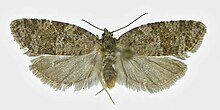| Flax tortrix | |
|---|---|

| |
| Mounted specimen | |

| |
| Living adult | |
| Scientific classification | |
| Domain: | Eukaryota |
| Kingdom: | Animalia |
| Phylum: | Arthropoda |
| Class: | Insecta |
| Order: | Lepidoptera |
| Family: | Tortricidae |
| Genus: | Cnephasia |
| Species: | C. asseclana |
| Binomial name | |
| Cnephasia asseclana (Denis & Schiffermüller, 1775) | |
| Synonyms | |
|
Numerous, see text | |
Cnephasia asseclana, the flax tortrix, is a moth of the family Tortricidae. It is found all over Europe.
The wingspan is 15–18 mm. Adults are on the wing from June to August.
The caterpillars feed on a wide range of herbaceous plants and even dry leaves and can become a pest. They initially mine the leaves. Later, they spin together leaves or flowers for pupation.
Taxonomy
The flax tortrix is part of a cryptic species complex, and its taxonomy has been quite confused. For long, it was known as "C. wahlbomiana", a name that has led to many misidentifications (see below) until it was finally suppressed in favor of C. virgaureana. That, however, subsequently turned out to refer to the same species as the earlier-described C. asseclana, and thus the latter name became the senior synonym. Obsolete scientific names (junior synonyms and others) of C. asseclana are:
- Cnephasia confluens Réal, 1952
- Cnephasia interjectana (Haworth, )
- Cnephasia latior Réal, 1953
- Cnephasia mediocris Réal, 1953
- Cnephasia oleraceana (Gibson, 1916)
- Cnephasia virgaureana (Treitschke, 1835)
- Cnephasia virgaurenana (lapsus)
- Cnephasia wahlbomiana (Linnaeus, 1758)
- Sciaphila virgaureana Treitschke, 1835
- Tortrix interjectana Haworth,
- Tortrix oleraceana Gibson, 1916
- Tortrix wahlbomiana Linnaeus, 1758
"C. wahlbomiana" was also variously applied to C. alticolana, C. cupressivorana, C. communana, C. genitalana, and probably others of the C. asseclana complex. In at least one seminal study, it was even used for Eana derivana as it seems.
Footnotes
- See references in Savela (2005)
- Grabe (1942)
- Chambon (1978), Baixeras et al. (2009), and see references in Savela (2005)
- E.g. C. chrysantheana, C. incertana, C. longana or C. pasiuana: Chambon (1978)
References
- Baixeras, J.; Brown, J.W. & Gilligan, T.M. (2009): Online World Catalogue of the Tortricidae – Cnephasia asseclana. Version 1.3.1. Retrieved 2009-JAN-20.
- Chambon, Jean-Pierre (1978): Biologie comparée et étude systématique des tordeuses nuisibles du genre Cnephasia . Cahiers de liaison de l'OPIE 29(2): 4-7 . PDF fulltext Archived 2012-03-05 at the Wayback Machine
- Savela, Markku (2005): Markku Savela's Lepidoptera and some other life forms – Cnephasia asseclana. Version of 2005-SEP-14. Retrieved 2010-APR-14.
- Grabe, Albert (1942): Eigenartige Geschmacksrichtungen bei Kleinschmetterlingsraupen . Zeitschrift des Wiener Entomologen-Vereins 27: 105-109 . PDF fulltext
External links
| Taxon identifiers | |
|---|---|
| Cnephasia asseclana |
|
This Tortricinae-related article is a stub. You can help Misplaced Pages by expanding it. |